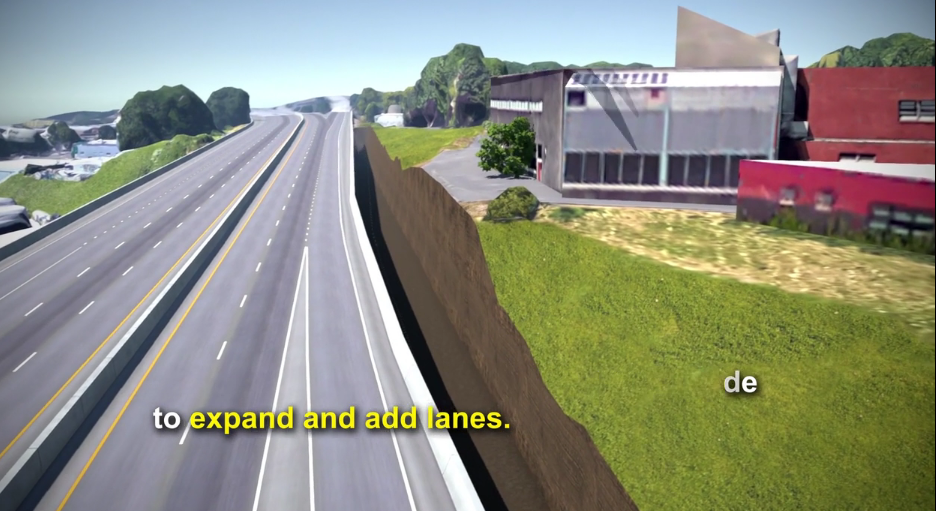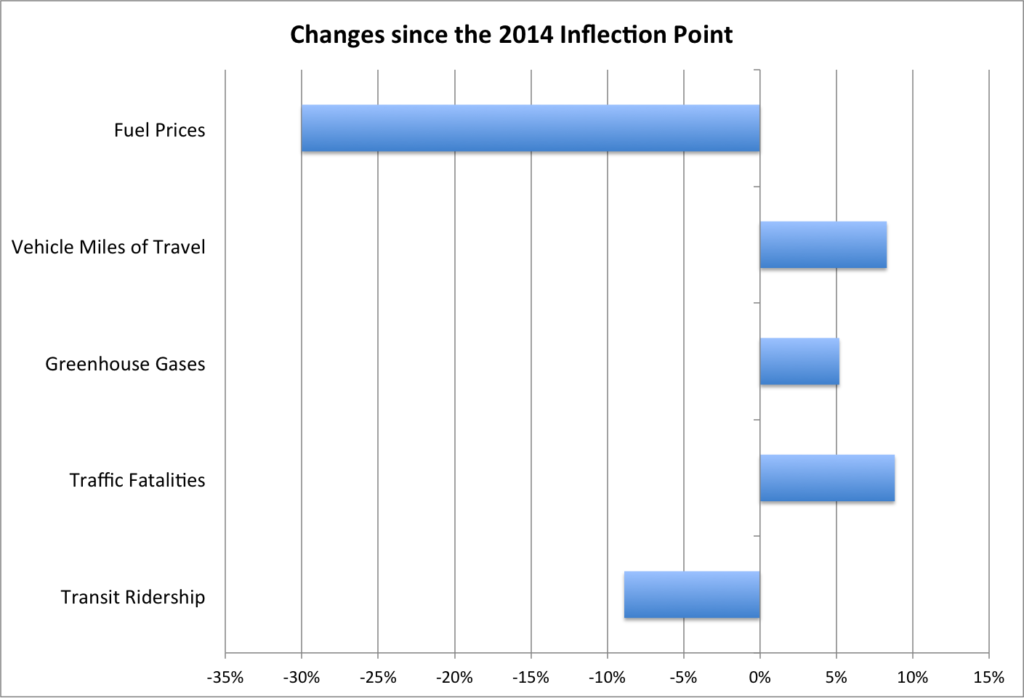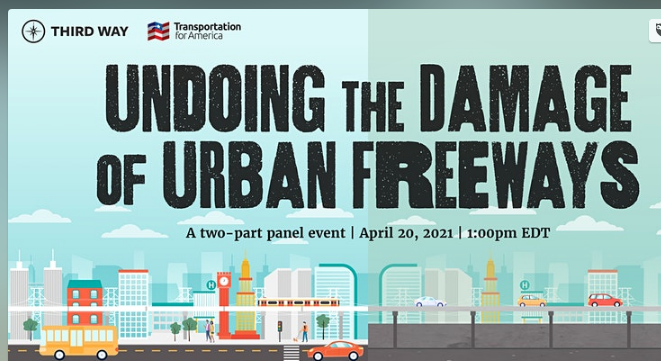What City Observatory this week
1. Taking Tubman: The Oregon Department of Transportation is planning to widen the Interstate 5 freeway in Portland into the backyard of Harriet Tubman Middle School. The $800 million widening project doubles down on the historical damage that ODOT highway construction has done to this neighborhood, and literally moves the freeway onto school grounds. The project also includes erecting two 1,000 foot long, 22 foot high “noise walls” (roughly twice the height of the Berlin Wall) between the school and the freeway. Already, the air at the school is unhealthy–so much so that the Portland school district had to spend $12 million on filtration equipment to make air inside the building clean enough to breathe.
A wider freeway will increase traffic, air pollution, and noise pollution at Tubman and in the surrounding neighborhood. At an April 9 demonstration, students and neighbors spoke out against the project.
2. ODOT’s peer review panel backs away from Rose Quarter traffic forecasts. A key dispute in the battle over the proposed I-5 Rose Quarter freeway widening project is whether it will increase air and noise pollution. Critics–including City Observatory–have pointed to flaws in the project’s traffic modeling that cause it to overstate traffic and pollution in the “no-build scenario” and to understate Induced demand in the build scenario. These errors, coupled with previously hidden plans showing ODOT plans a 10-lane freeway, rather than the 6-lane facility in modeled, mean that the project’s environmental assessment is wrong. In attempting to defend its flawed modeling, ODOT has repeatedly pointed to a “peer review” panel it convened in 2020. But last week, the leader of that peer review panel specifically said that they did not look at the accuracy of ODOT’s traffic projects, and can’t vouch for them. The peer review panel has made it clear that claims that its review “supports” ODOT’s work and “confirms” its findings are simply false. The panel members were instructed to look only at a small, and as it turns out, derivative question, and simply ignored whether the freeway widening increases traffic.
3. Our real climate and transportation policy is cheap gas. Mayors and Governors like to tout bold climate goals (typically decades in the future), but our real climate policy is expressed by what we’re doing right now. And across the nation, regardless of your rhetoric, your real climate policy is expressed at the gas pump. The very low prices that Americans pay for gasoline are the dominant policy decision for both climate and urban transportation. A quick look back at the past seven years shows that the 40 percent decline in gas prices in 2014 caused a whole range of key climate and transportation policy measures to move rapidly in the wrong direction. Public transit ridership, which had been increased, fell abruptly. Miles driven, which had plateaued, suddenly grew. Greenhouse gas emissions from transportation and road deaths increased sharply. And Americans, who had been buying equal numbers of cars and SUVs, decisively shifted to buying about 70 percent SUVs.
As long as we persist in keeping fuel prices low, both by global standards, and relative to the damage done by all this driving, we’ll continue to have frustratingly poor transportation systems and ever worsening climate problems.
Must read
1. Ed Glaeser on tying infrastructure funding to zoning reform. Part of the Biden Administration’s $1.9 trillion infrastructure package is a grant program that would give local governments money in recognition of efforts to eliminate exclusionary zoning policies, like large lot sizes, apartment bans and parking requirements. But, according to Glaeser, dean of US urban economists, this carrot is too small to motivate policy changes, especially among the jurisdictions who practice the most egregious and persistent forms of exclusion. He argues:
. . . a competitive grant program is too weak to overcome the entrenched interests — like the homeowners who control local zoning boards and the wealthy residents of cooperatives who oppose all neighborhood change — that limit building in productive places. If the president wants to break the country out of its zoning straitjacket, the infrastructure plan should ensure that no benefits go to states that fail to make verifiable progress enabling housing construction in their high-wage, high-opportunity areas.
2. Community Benefits Agreement in Sacramento. Big new investments in distressed urban neighborhoods often raise concerns about displacement, and one of the ways to assure that the benefits of new investment are widely shared is a community benefits agreement. Darrene Hackler lays out the process and details that produced a community benefits agreement for Sacramento’s proposed Innovation District. The University of California Davis is partnering to build a $1 billion research and development center, and the city and developers have agreed to a $50 million fund to provide a range of benefits including affordable housing in the area. Hackler’s report, published at Smart Incentives, also includes an analysis of community benefit agreements in other cities.
3. What good is transit if people can’t live nearby? Sightline’s Michael Andersen reports on legislation pending before the Oregon Legislature to automatically legalize higher density housing near transit service. As Anderson explains,
On land zoned for housing within one-eighth of a mile of a high-capacity transit station, the bill would strike down local bans on buildings that create up to 45 homes per net acre. In other words, it would legalize three-story attached housing within about three blocks of stations. . . . there’s [also] a provision for greater flexibility: jurisdictions can also opt to keep lower density at some stops and legalize five to six story buildings at other stops, if they prefer, as long as they achieve the same overall density within the 1/8-mile station areas.
It is, as Andersen argues, a modest ask. But nonetheless, it’s drawn the opposition of NIMBY’s, and surprisingly, some transit agencies. The NIMBY opposition is predictable. Transit agencies fear that if transit service (like frequent buses or new light rail stops) brings with it a guarantee of higher allowable densities, it will be harder for them to expand service. As Andersen points out, however, does it make any sense to spend scarce transit resources improving service to an area that doesn’t have the kind of densities needed to make transit work?
4. How to repair the damage done by urban freeways. Usually our Week Observed must read feature highlights insightful views that have already been published, but this week, we’re alerting you to an upcoming event that’s something you might want to attend.
Sponsored by the Third Way and Transportation for America, the webinar is on April 20. Registration is free.
New Knowledge
Subsidizing single family houses aggravated climate change. A recent study published in Environmental Science and Technology considers how our national policy of subsidizing single family housing has led to an increase in the nation’s carbon emissions. A series of federal (and local) policies have tilted the housing market toward single family homes: the construction of the interstate highway system, subsidies to homeownership, redlining of many urban neighborhoods, and local zoning that greatly restricts multifamily development. The authors of this paper construct a counterfactual estimate of what US residential greenhouse gas emissions would be if these policies had been more neutral between single- and multi-family housing.
The following chart summarizes their analysis of a series of counterfactual estimates of US residential energy demand based on varying mixes of housing types and sizes. The two left hand columns show the mix of housing units (actual and counterfactual); the net effect is changing about 14 million houses built between 1970 and 2015 from single family to multifamily, about a 14 percent shift in the share of multi-family homes in the housing stock in 2015. The five right hand columns show the total residential energy consumption associated with a series of alternatives where housing sizes vary. The greatest reductions in energy use are associated with a switch to 30 percent or 50 percent smaller units. Just moving the average household to this mix of multi-and single family, without changing housing unit size (CF 2), reduces per household residential energy consumption more than one-fourth from the levels actually recorded.
Shifting to more multi-family housing would lower energy consumption, decrease household energy bills and lower greenhouse gas emissions. As the authors conclude:
Federal housing policy changes have encouraged construction of single-family housing and suppressed multifamily housing, increasing residential energy demand and GHG emissions. Increasing the multifamily share of housing can be expected to produce energy large savings, even with no change of household income or floor area. Policies that suppress demand and restrict supply of multifamily housing thereby directly obstruct a large potential for residential GHG emission reductions. Housing policy can support climate policy by removing barriers and disincentives to multifamily housing.
Finally, if anything, its likely that these estimates understate the energy savings and greenhouse gas reductions from increase multi-family housing. Multi-family housing has, by definition, higher density, and higher density tends to be associated with lower car ownership and fewer vehicle miles traveled per person, so it is likely that there would be savings in transportation related energy and pollution as well, factors not estimated in this paper.
Peter Berrill, Kenneth T. Gillingham & Edgar G. Hertwich, “Linking Housing Policy, Housing Typology, and Residential Energy Demand in the United States,” Environ. Sci. Technol. 2021, 55, 4, 2224–2233. Publication Date:January 28, 2021.
https://doi.org/10.1021/acs.est.0c05696
In the News
Bike Portland featured Joe Cortright’s remarks at the No More Freeways rally at Harriet Tubman Middle School.





